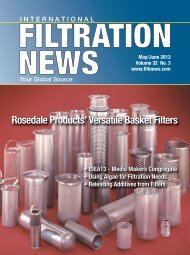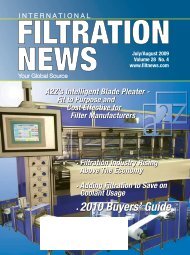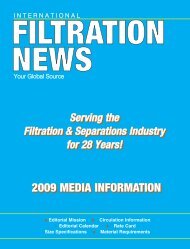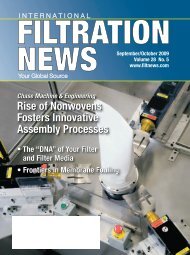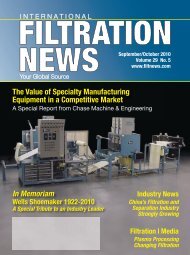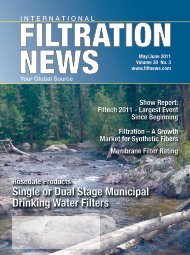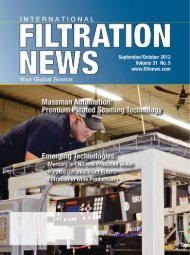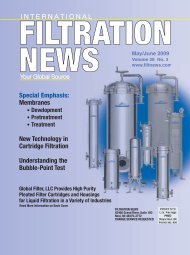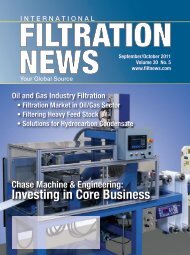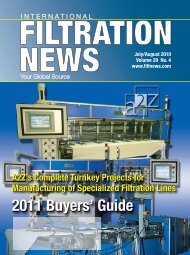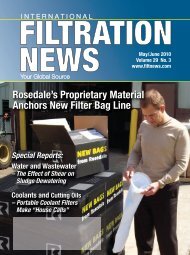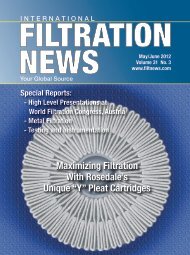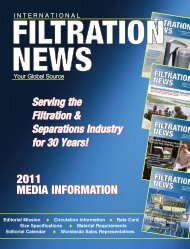2014 Buyers' Guide - Filtration News
2014 Buyers' Guide - Filtration News
2014 Buyers' Guide - Filtration News
- No tags were found...
You also want an ePaper? Increase the reach of your titles
YUMPU automatically turns print PDFs into web optimized ePapers that Google loves.
Process | EngineeringIllustration 2: Liquid Metal Embrittlement, LNG Plant – Skikda, Algerialayed production by almost five years.There are multiple other recent examplesas well. Concentrations of mercuryvary from region to region, but itis always there. Areas of SoutheastAsia, Europe and Eurasia, for example,can have anywhere from 70 to3,500 µg/m3 of mercury according toa recent report by the Natural ResourcesDefense Council. The worldwideproduction of natural gas is 3.3trillion cubic feet per year. Each 1,000µg/m3 generates 6 million pounds ofmercury. This can theoretically contributefrom nearly 2 million to 21million pounds of mercury from thisregion alone. Some of this mercury isremoved in the production process;approximately one-third is burned offinto the atmosphere at the thermal oxidizers,and the fate of the rest is unknownalthough it is safe to assumethat some of it ends up in the product.Mercury in the production processand in the end product is highly undesirabledue to its corrosive effectson equipment and its detrimental effectsto living things and ecosystems,especially after it is transformed tohighly toxic organic states, which canaccumulate in the food web.The presence of mercury has beenan issue in production (see Illustrations1 and 2) and is now becoming anobstacle in the adoption of LNG in sectors,which are eager to switch. Onesuch sector is commercial shipping.Commercial shipping has found it verydifficult to comply with sulfur and nitrogenoxide emissions with the type offuels they use (Bunker C or marinediesel oil). These fuels are rich in sulfurand highly polluting. Natural gaspractically eliminates this concern (seeTable 2), however, ships are composedprimarily of metal and the concern ofmercury embrittlement of metal mustbe addressed before adoption.12 • August 2013 • www.filtnews.comPROPULSIONMercury is generated with the gasand attempts to remediate are currentlylimited to the productionprocess, in many cases, as an unintendedand undesirable secondary effectof other processes. In theproduction of LNG it is vital to removeall traces of water, hydrocarbonsand other compounds, whichare liquids at room temperature. Ifthese materials pass through to theliquefication process it can result ininefficiency or even catastrophic failure.Therefore, in the production ofnatural gas, multiple redundantprocesses exist for the removal ofthese liquids. Mercury is oftendragged along. The first significantremediation process is coalescence,whereby all the liquids, which can bephysically coalesced are removed andresults in a variable mixture referredto as condensate, which is approximately50% water and 50% assortedhydrocarbons. Some mercury is removedat this stage. After coalescence,polishing processes areemployed, using molecular sieves topolish out any traces of water and activatedcarbon to polish out anyresidual liquid hydrocarbons. Sometimesthe carbon is modified withsulfides, colloidal precious metals orbromides in order to polish out residualmercury. Some mercury is removedat this stage. After theliquefication process, the gas is usuallyprocessed through a reverse osmosismembrane to recover anyresidual liquefiable hydrocarbonsand to discard and burn off non-liquefiablehydrocarbons at the thermaloxidizer. We know that the coalescingand polishing process steps areonly partially effective because measurementsof mercury at the thermaloxidizer can often be as high as 1ppmand concentrations in the retainedgas can be equally high.In order to eliminate the mercuryimpediment, we must understandwhy multiple redundant coalescenceand polishing processes, and even



